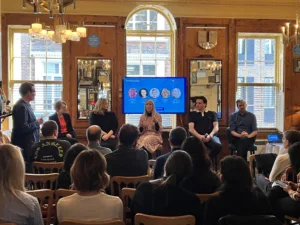NDA recently held a roundtable, in partnership with Permutive, to discuss the role of first-party data in the privacy-first world. We were joined by Pete Markey, Chief Marketing Officer at Boots UK; Barbara Piras, Head of Performance Marketing at Tui Group; Ian Kelly, Global Lead, Connected Experience Programme at Reckitt; Sam Gaunt, Northern Europe Media Director at GSK; and Permutive Head of Advertiser Strategy, Elizabeth Brennan.
“First-party data is, simply put, any data that is collected directly from the customer by our brands or products,” that’s how Reckitt’s Kelly would define first-party data, and it’s hard to argue with that. First-party data is any data that’s shared directly with a brand or publisher. Simple enough, right?
First-party data has been front of mind for advertisers and publishers for quite some time now but you, seemingly, can’t go a day without hearing a mention of third-party cookies. As advertisers realise the value of publishers’ first-party, they’re also seeing a need to collect their own first-party data as an alternative to relying on third-party cookies. Valued information
With the death of third-party cookies on Google’s Chrome browser eventually on the way, the importance of first-party data is increasing, and advertisers and publishers are trying to figure out ways to maximise the value of the data they own.
“The data that you own as a business tends to be your first-party data,” said Permutive’s Brennan. Publishers, in particular, “have this wealth of information about everyone who is coming to their site. They’re able to d create a very holistic view on everyone who’s visiting them. They’ve got a nice in-depth understanding of patterns of behaviour for different users, interest segments etc.”
Publishers may have this wealth of information on everyone who visits their sites, but some brands aren’t in too much of a bad position themselves when it comes to the first-party data they own. Take, for instance, Tui, which has “a massive wealth of information about our customers through booking data,” according to Tui’s Piras.
“Everything that happens during the booking interaction – the website behaviour, your travel patterns, where you flew from, what you’ve done on holiday, your preferences, your food allergies or intolerances,” said Piras. “It’s really a full breadth of information about who our guest really is. And it’s important because we don’t just want to sell them things, it’s about the experience as well.”
Then there’s a company like Boots, which has one of the UK’s most popular loyalty schemes. Its 24-year-old Advantage Card programme has over 10 million people using the card on a regular basis, so there’s a huge amount of first-party data available there.
“We obviously get first-party data from people that shop on our website, which has had 100%-plus growth in the last year and a half, but the Advantage Card is really our central collection of first-party data,” explained Boots’ Markey.
“We view it as a way to build relationships with customers, because we get to know what people like, their shopping patterns, the sorts of products they buy, and the sorts of brands they like. That helps us to do a lot more mass personalisation at scale, where we can provide the right content, the right offer, the right communication, to the right customer at the right time.
“First-party data is really important to us, and a key pillar of our strategy. Around 30% of the media we now buy is using first-party data. It’s central to what we do in terms of not just our own channels, but our paid media strategy now as well.”
Data implementation
When it comes to actually utilising first-party data, companies have different ways of seeking to get the most out of their data.
At Reckitt – the CPG firm behind brands like Dettol, Air Wick, Vanish, Nurofen, and Finish, to name a few – the company uses first-party data to power its ‘connected experience’ programme, which focuses on using the data gained directly from its products to create experiences for consumers.
“The ambition of the programme is to use the products as the vehicles to have personalised conversations at scale,” said Reckitt’s Kelly. “We have billions of products in the marketplace, so those products being interacted with at the point of use is very compelling for an organisation like Reckitt. Then there’s the ability to then engage with the customer through richer experiencers, and gather the data from those experiences, which can feed further campaigns.
“We’re using products that are in people’s hands or in their environment, not just at purchase, but before purchase, at use, and at reuse, to have those conversations and to have those enhanced experiences.”
Meanwhile, pharmaceutical and consumer healthcare company GSK thinks about its use on first-party data on a brand-by-brand basis.
“We have a range of consumer healthcare brands, and the roles those brands have in people’s lives is hugely variable. It’s the same for the role of first-party data,” said GSK’s Gaunt. How big the role of first-party data is depends on the advertiser and the type of brand.
“A brand like Aquafresh, which isn’t medicinal and is just a quality toothpaste for the whole family, has broad reach and mass appeal, so broadcast has a huge role to play. There’s still an opportunity to drive more personal communication but, in the context of the broader marketing mix, it’s going to be less important than a brand which is a clear solution to a consumer problem, where we have the opportunity to drive understanding around the medicinal properties around some of our brands and the role they can play in consumers’ lives.”









